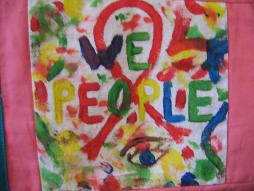HIV/AIDS is one of the most significant human, health, and development issues facing Africa today. NGOs and health care providers are increasingly turning to mobile phones to address the unique challenges of AIDS awareness, prevention and treatment. "HIV/AIDS is arguably the most pressing development problem facing South Africa – and Africa," asserts a report by the United Nations Children's Fund (UNICEF ) and Women'sNet, a South African network of people who use ICTs in gender-related advocacy and support. The report, titled "Rapid Assessment of Cell Phones for Development," is available here on the UNICEF website.
The document, written and compiled by Sally-Jean Shackleton of Women'sNet with contributions by Toni Eliasz of Ungana-Afrika, is an overview and analysis of mobile usage in development projects, mainly in South Africa. Most of the projects profiled in the report deal with health issues, especially regarding HIV/AIDS.
In addition to summaries of 17 projects currently addressing health issues in South Africa and neighboring areas, the report contains four case studies of current health initiatives with mobile phones. These case studies, written by Toni Eliasz, profile Simpill, Cell-Life, the Fahamu-UmNyango Project (which we wrote about here on the MobileActive blog), and the UWC project, and provide a deeper analysis into the methodologies, successes, and results of these projects.
Simpill is a special pill bottle that, when opened, delivers an SMS to a central server. If the server doesn't receive the SMS, it can then be programmed to send a message to the patient or to various support services, like family, friends or community health organizations. Simpill has been shown to be effective in reminding patients with tuberculosis to take their medicine. According to the report, feedback from users of Simpill has been positive, and 100% of survey respondents said they would like to use Simpill if they were to contract TB again. However, the authors note that while Simpill has been shown to be effective for TB, more testing is required to evaluate its efficacy against HIV/AIDS. "It is not yet clear how feasible the solution is for HIV/AIDS treatment since the adherence requirements are more complex requiring combination of medications with time, dosage and meal requirements. However, TB is a significant danger, and a leading cause of death for HIV+ people," they write. Additionally, Simpill is a for-profit company, not an NGO, so at this time costs are still restrictive. The authors question whether Simpill will focus more on international markets than smaller, less profitable African ones because they are primarily profit-driven.
Another case study in the report profiles Cell-Life, a Cape Town based NGO that develops applications used by home-care workers to transit HIV/AIDS data. Home-care workers in the Vodacom-sponsored Cell-Life Aftercare program are each assigned 15-20 patients who are monitored in their homes. The health worker transmits necessary data -- such as medication, socio-economic factors affecting treatment, or symptoms -- via mobile to a central server, where the data is recorded and necessary responses are sent. The authors conclude that despite some basic problems, such as long-term sustainability and the difficulty of implementation on a large scale, Cell-Life is a promising project in HIV/AIDS treatment. They write, "Cell-Life is one of the most experienced initiatives combining mobile phone technologies and the management of HIV/AIDS in South Africa."
One of the strengths of the UNICEF/Women'sNet report are the criteria for reviewing the case studies that include accessibility, appropriateness, affordability, functionality, and development. The reviews are, for the most part, balanced and impartial, with a careful examination of both the positive and negative long and short term effects of each project. The authors are aware of societal factors, such as high rates of mobile phone crime and cultural factors affecting mobile usage. They also take into account the privacy desired and the cultural sensitivity that is necessary when addressing HIV/AIDS issues. The report addresses the sustainability of each project, which is necessary when dealing with life-long health issues such as HIV/AIDS. They address the problems that can arise from lack of reliable funding and projects that, after becoming a vital part of individuals' health networks, suddenly disappear after the funding dries up.
However, despite these strengths, the report leaves some unanswered questions. While the authors certainly realize the potential of mobiles to have a positive impact on women's health issues, especially in dealing with HIV/AIDS, they fail to tie these issues into meaningful conclusions that address the profiled projects. In the initial pages of the report they address several issues relating to gender, and later, in their section "Key considerations for cell-phone use in development practice," the authors address several other gender concerns, including inequality of access to technology and domestic violence. One of their gender considerations reads, "How do women use cellular technology differently to men – studies show that women have less power over the communication tool than men do." A more detailed discussion of this issue could have been desireable. If power means ability to prevent disease (a girl in South Africa is more likely to be raped than be able to read by age 8) access treatment and care, and access and use technology, are there projecs and advocacy addressing this? It would have also been useful to include ways that mobiles can actually reinforce gender roles -- something that MobileActive's guest writer Abi Jagun has written about here -- and how this impacts the efficacy of mobiles in HIV/AIDS work.
Overall, the UNICEF/Women'sNet study provides a solid overview of some of the projects that are using mobiles to address healthcare needs in South Africa. Most importantly, the report notes that "For the most part, technology is not the limitation in projects - skills, capacity and management systems most often are. The culture and norms of the location of the project have a significant impact on the potential success or failure of the intervention." This work must start with people first. Always.
Phot courtesy Hot Foot.


Post new comment